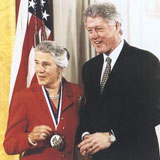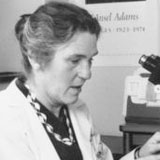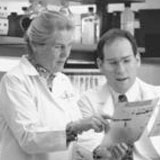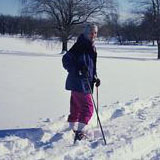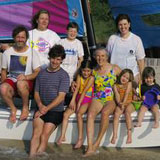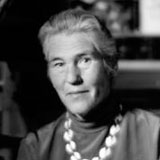Biography: Dr. Janet Davison Rowley

Year: 1973
Achievement: In the 1970s, Dr. Janet Rowley identified a specific genetic “translocation” in leukemia, heralding a new understanding of the role of some translocations in specific cancers.
In grammar school and high school, I was always fascinated by science. I especially like the orderliness of the classification of plants and animals in a logical phylogenetic tree. At the University of Chicago, I was in an advanced biology class that included many pre-med students. I realized that medicine would combine my interest in science with my desire to have a profession that helped others.
In the early 1970s Dr. Janet Rowley identified a process of "translocation," or the exchange of genetic material between chromosomes in patients with leukemia. This discovery, along with Dr. Rowley's subsequent work on chromosomal abnormalities, has revolutionized the medical understanding of the role of genetic exchange and damage in causing disease.
Janet Davison was born in New York City in 1925, the only child born to Hurford and Ethel Ballantyne Davison, both of whom had earned advanced degrees. Her father held a master of business administration from Harvard Business School, and her mother had graduated with a master's degree in education from Columbia University. Both became educators at the college and high school levels respectively, her mother later giving up teaching to become a school librarian.
Both parents encouraged their daughter's education, enrolling Davison in an academically challenging junior high school in New Jersey. She studied diligently and was an avid reader, becoming especially interested in science. In 1940, she was granted a scholarship to study at the University of Chicago. Beginning at the age of 15, she finished the last two years of high school and the first two years of college in an advanced placement program, learning to think for herself and study independently. These skills were the ideal foundation for a research career.
Davison remained at the University of Chicago and earned a bachelor of philosophy degree in 1944, a bachelor of science degree in 1946, and doctor of medicine degree in 1948. She married Donald Adams Rowley, also a physician, the day after graduating from medical school. For the next twenty years, Dr. Rowley balanced family life with her career by working part-time as she raised four sons. She began full-time research when the youngest was 12 years old.
After earning her medical license in 1951, Dr. Rowley worked as attending physician at the Infant and Prenatal Clinics in the Department of Public Health, Montgomery County, Maryland. In 1955 she took up a research post at Chicago's Dr. Julian Levinson Foundation, a clinic for children with developmental disabilities, where she remained until 1961. She also taught neurology at the University Illinois School of Medicine.
In 1962, after a year in England as an NIH trainee, studying the pattern of deoxyribonucleaic acid (DNA) replication in normal and abnormal human chromosomes, Dr. Rowley returned to the University of Chicago, as a research associate in the Department of Hematology. She became an associate professor in 1969, and a full professor in 1977. In the 1970s, she further developed the use of existing methods of quinacrine flourescence and Giemsa staining to identify chromosomes, and demonstrated that the abnormal Philadelphia chromosome implicated in certain types of leukemia was involved in a translocation with chromosome 9 in some cases. Translocation is the process by which a piece of one chromosome breaks off and joins another chromosome, or when two chromosomes exchange material when both break. She also identified translocation between chromosomes 8 and 21 in myeloblastic leukemia.
When Dr. Rowley published her findings in the 1970s, she argued that specific translocations caused specific diseases, going against the established view of the cause of cancer which gave little significance to chromosomal abnormalities. Although there was some resistance to her ideas at first, her work has proven immensely influential, and by 1990 over seventy translocations had been identified across different cancers.
In 1984, Dr. Rowley was made the Blum-Riese Distinguished Service Professor at the University of Chicago, a position she still holds, as well as serving as the interim deputy dean for science since 2001. In 1998, she was one of three scientists awarded the prestigious Lasker Award for their work on translocation. She has published over four hundred articles and continues her research at the University of Chicago.
What was my biggest obstacle?
In 1944, the quota for women at the University was 3 in a class of 65 medical students. The quota was filled for the class I wanted to enter so I had to wait 9 months. This really was not such a hardship because I still entered medical school when I had just turned 20.
How do I make a difference?
When I practiced medicine, I took care of mentally retarded children; the parents were under great stress because many of the children were difficult to manage because of severe behavior problems, whereas others were so handicapped that they needed as much care as a baby even though they were older and weighed a lot. I tried to be as gentle in examining the children as possible while providing the parents with the assurance that someone understood (or tried hard to understand) their problems and would try to ameliorate their difficult situation.
In research, I had the extraordinary good fortune to make a series of discoveries about genetic (cytogenetic or chromosome) changes in human leukemia and lymphoma. I discovered the existence of chromosome translocations in leukemia in 1972 and then identified a number of common translocations in both leukemia and lymphoma. Others identified the genes at some translocation breakpoints, but my laboratory also contributed to this effort. Today, the 9;22 tranlocation in chronic myelogenous leukemia (CML) is treated with a specific drug, Gleevec, that induces remissions in the vast majority of patients. To have contributed to this marvelous success study is truly a rewarding experience.
Who was my mentor?
My mother deserves a great deal of credit. She was a teacher in Chicago and she always supported me; she knew about scholarships at the University of Chigaco, and encouraged me to apply. Once at the University, I had inspiring teachers in college and in medical school. When I began research, Dr. Leon Jacobson and Dr. Charles Huggins (a Nobel Laureate) were both mentors and later wonderful friends.
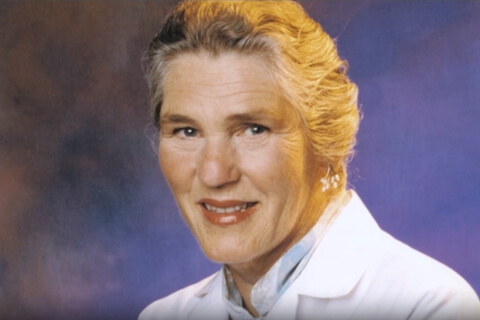
Dr. Janet Davison Rowley
Dr. Janet Davison Rowley
In the 1970s, Dr. Janet Rowley brought a new understanding to the role of genetics in disease when she demonstrated that the translocation of chromosomes played a significant role in some cancers. A dedicated student, she received a scholarship to the University of Chicago when she was fifteen years old, and completed the last two years of high school and the first two years of college in an accelerated program of study at the University. She stayed on to complete her pre-medical training and attend the medical school and graduated with an M.D. degree in 1948. She married Donald Rowley, also a physician, the day after graduating from medical school. For twenty years, Dr. Rowley chose to work part-time, in order to be with her children. When the youngest was twelve, she turned to full-time research. She became interested in genetics while working at the Dr. Julian Levison Foundation, a clinic for children with developmental disabilities. In 1961, funded by the National Institutes of Health, she traveled to Oxford, England, to study chromosomes at a radiobiology laboratory. There, she investigated the pattern of DNA replication in normal and abnormal human chromosomes. A year later, at the end of the project, Dr. Rowley returned to the University of Chicago to continue her research. In the early 1970s, she brought a new perspective to the understanding of cancer by demonstrating that the abnormal chromosome implicated in certain types of leukemia was also involved in a translocation, in some cases. By 1990, over seventy chromosomal translocations had been identified across different types of cancer. Today, Dr. Rowley continues her research at the University of Chicago. She holds the position of the Blum-Riese Distinguished Service Professor, and serves as the Interim Deputy Dean for Science. In 1998, Dr. Janet Rowley was awarded the prestigious Lasker Award for her work on translocation and cancer.




